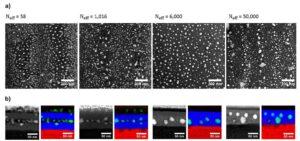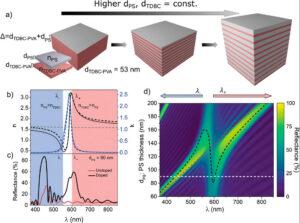2022 Publications
Influence of Heat Accumulation on Morphology Debris Deposition and Wetting of LIPSS on Steel upon High Repetition Rate Femtosecond Pulses Irradiation
Materials, Volume 15
Abstract
Ultrafast Electron Dynamics and Optical Interference Tomography of Laser Excited Steel
Yasser Fuentes-Edfuf, Mario Garcia-Lechuga, Javier Solis, Jan Siegel
Laser & Photonics Reviews, Volume 16
Abstract
Spectroscopic ellipsometry study of Cu2Zn(GexSi1-x)Se4 bulk poly-crystals
ElenaHajdeu-Chicarosh, Sergiu Levcenko, Rosalia Serna, Ivan V. Bodnar, Ivan A. Victorov, Oxana Iaseniuc, Raquel Caballero, José Manuel Merino, Ernest Arushanov, Máximo León
Solid State Sciences, Volume 132
Abstract
Propagation dynamics of the solid-liquid interface in Ge upon ns and fs laser irradiation
J. Phys. D: Appl. Phys. 55, 365104 (2022)
Abstract
Pulsed laser deposition and structural evolution of BaF2 nanolayers in Eu-doped BaF2/Al2O3 layered optical nanocomposite thin films
Yu Jin, Charles W.Bond, Pilar Gomez-Rodrigue, Eva Nieto-Pinero, Russell L. Leonard, David J. Gosztola, Jacqueline A. Johnson, Jose Gonzalo, Rosalia Serna, Amanda K. Petford-Long
Thin Solid Films, Volume 754
Abstract
Mechanisms driving self-organization phenomena in random plasmonic metasurfaces under multipulse femtosecond laser exposure: A multitime scale study
Balint Eles, Paul Rouquette, Jan Siegel, Claude Amra, Julien Lumeau, Antonin Moreau, Christophe Hubert, Myriam Zerrad and Nathalie Destouches
Nanophotonics, Volume 11 Issue 10
Abstract
Laser-induced transformations of plasmonic metasurfaces pave the way for controlling their anisotropic optical response with a micrometric resolution over large surfaces. Understanding the transient state of matter is crucial to optimize laser processing and reach specific optical properties. This article proposes an experimental and numerical study to follow and explain the diverse irreversible transformations encountered by a random plasmonic metasurface submitted to multiple femtosecond laser pulses at a high repetition rate. A pump-probe spectroscopic imaging setup records pulse after pulse, and with a nanosecond time resolution, the polarized transmission spectra of the plasmonic metasurface, submitted to 50,000 ultrashort laser pulses at 75 kHz. The measurements reveal different regimes, occurring in different ranges of accumulated pulse numbers, where successive self-organized embedded periodic nanostructures with very different periods are observed by post-mortem electron microscopy characterizations. Analyses are carried out; thanks to laser-induced temperature rise simulations and calculations of the mode effective indices that can be guided in the structure. The overall study provides a detailed insight into successive mechanisms leading to shape transformation and self-organization in the system, their respective predominance as a function of the laser-induced temperature relative to the melting temperature of metallic nanoparticles and their kinetics. The article also demonstrates the dependence of the self-organized period on the guided-mode effective index, which approaches a resonance due to system transformation. Such anisotropic plasmonic metasurfaces have a great potential for security printing or data storage, and better understanding their formation opens the way to smart optimization of their properties.
Enhanced Light Absorption in All‐Polymer Biomimetic Photonic Structures by Near‐Zero‐Index Organic Matter
Miguel A. Castillo, C. Estévez-Varela, William P. Wardley, R. Serna, I. Pastoriza-Santos, S. Núñez-Sánchez, Martin Lopez-Garcia
Advanced Functional Materials, art. no. 2113039
Abstract
Natural photosynthetic photonic nanostructures can show sophisticated light–matter interactions including enhanced light absorption by slow light even for highly pigmented systems. Beyond fundamental biology aspects, these natural nanostructures are very attractive as blueprints for advanced photonic devices. But the soft-matter biomimetic implementations of such nanostructures is challenging due to the low refractive index contrast of most organic photonic structures. Excitonic organic materials with near-zero index (NZI) optical properties allow overcoming these bottlenecks. Here, it is demonstrated that the combination of NZI thin films with photonic multilayers like the ones found in nature enables broadband tunable strong reflectance as well as slow light absorption enhancement and tailored photoluminescence properties in the full VIS spectrum. Moreover, it is shown that this complex optical response is tunable, paving the way toward the development of active devices based on all-polymer and near-zero index materials photonic structures.
Multiscale ultrafast laser texturing of marble for reduced surface wetting
Ariza, R., Alvarez-Alegria, M., Costas, G., Tribaldo, L., R. Gonzalez-Elipe, A., Siegel, J., Solis, J.
Applied Surface Science, 577, art. no. 151850
Abstract
The modification of the wetting properties of marble surfaces upon multi-scale texturing induced by ultrafast laser processing (340 fs pulse duration, 1030 nm wavelength) has been investigated with the aim of evaluating its potential for surface protection. The contact angle (CA) of a water drop placed on the surface was used to assess the wettability of the processed areas. Although the surfaces are initially hydrophilic upon laser treatment, after a few days they develop a strong hydrophobic behavior. Marble surfaces have been irradiated with different scan line separations to elucidate the relative roles of multi-scale roughness (nano- and micro-texture) and chemical changes at the surface. The time evolution of the contact angle has been then monitored up to 11 months after treatment. A short and a long-term evolution, associated to the combined effect of multi-scale roughness and the attachment of chemical species at the surface over the time, have been observed. XPS and ATR measurements are consistent with the progressive hydroxylation of the laser treated surfaces although the additional contribution of hydrocarbon adsorbates to the wettability evolution cannot be ruled-out. The robustness of the results has been tested by CA measurements after cleaning in different conditions with very positive results.
Nanosecond Laser Switching of Phase-Change Random Metasurfaces with Tunable ON-State
Alvarez-Alegria, M., Siegel, J., Garcia-Pardo, M., Cabello, F., Toudert, J., Haro-Poniatowski, E., Serna, R.
Advanced Optical Materials, 10 (3), art. no. 2101405,
Abstract
Single-Step Fabrication of High-Performance Extraordinary Transmission Plasmonic Metasurfaces Employing Ultrafast Lasers
Ruiz de Galarreta, C., Casquero, N., Humphreys, E., Bertolotti, J., Solis, J., Wright, C.D., Siegel, J.
ACS Applied Materials and Interfaces, 14 (2), pp. 3446-3454
Abstract
Transparent high conductive Titanium oxynitride nanofilms obtained by nucleation control for sustainable optolectronics
E.Enríqueza, A.Mariscal, R.Serna, J.F.Fernández
Applied Surface Science Volume 574, 1 February 2022
Abstract
Transparent conducting thin films have attracted a lot of interest in last decades because they have become essential electrodes for optoelectronics applications. Indium tin oxide (ITO) is the transparent conductor par excellence with 80% transmittance in the visible range and a resistivity of 10−4 Ω·cm. Unfortunately, ITO is toxic, brittle and very expensive due to the Indium scarcity in the earth’s crust. For this reason, sustainable alternatives are being sought. Titanium oxynitrides are a very interesting alternative, titanium is abundant and its oxynitrides show remarkable mechanical, electrical and optical properties that can be tailored by modifying the N/O ratio. However, achieving the balance between transparency and conductivity to design a suitable electrode is a challenging milestone. In this work we prepared high quality TiON nanofilms by PLD (pulsed laser deposition) in vacuum, tuning the transparency and conducting properties by varying the deposition laser energy to control the N/O ratio. The absence of gases flux achieves defect-free films with transparency up to 50% and similar conductivity to ITO (1.8·102 S/cm). These results open a new line of research for the development of sustainable transparent conducting electrodes based on dense and planar TION films, very useful for electronic and optical devices, solar cells or photonics.












